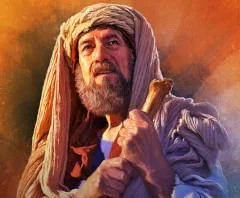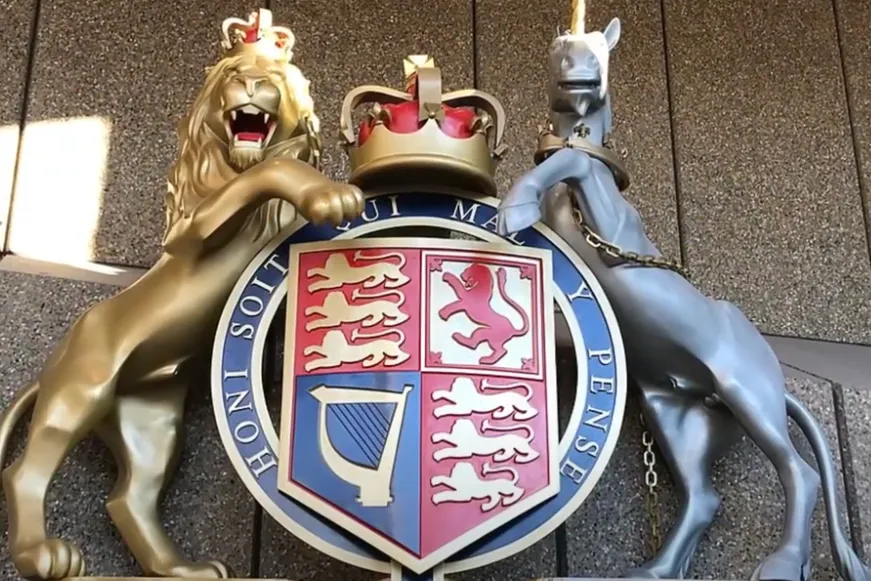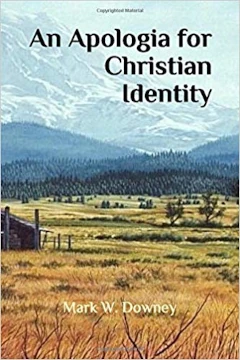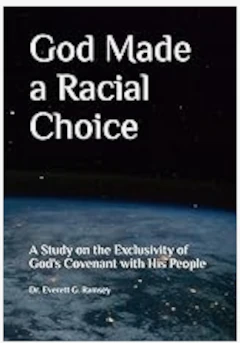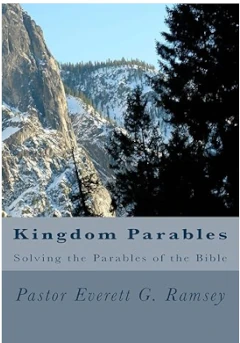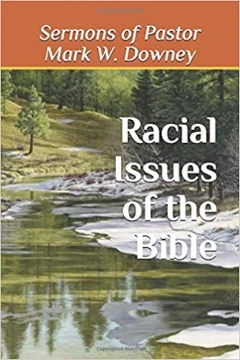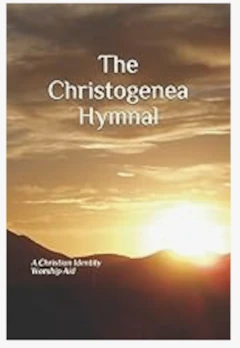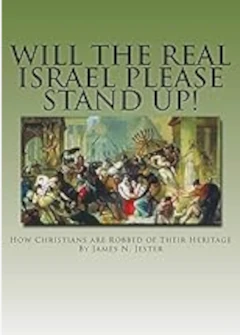Queen of Heaven
Copied from the sermon notes of Pastor Don Elmore
February 21, 2016
Scripture Reading: Jeremiah 7:13-20
13) “And now, because ye have done all these works, saith the LORD, and I spake unto you, rising up early and speaking, but ye heard not; and I called you, but ye answered not;
14) Therefore will I do unto this house, which is called by my name, wherein ye trust, and unto the place which I gave to you and to your fathers, as I have done to Shiloh.
15) And I will cast you out of my sight as I have cast out all your brethren, even the whole seed of Ephraim.
16) Therefore pray not thou for this people, neither lift up cry nor prayer for them, neither make intercession to me: for I will not hear thee.
17) Seest thou not what they do in the cities of Judah and in the streets of Jerusalem?
18) The children gather wood, and the fathers kindle the fire, and the women knead their dough, to make cakes for the queen of heaven, and to pour out drink offerings unto other gods, that they may provoke me to anger.
19) Do they provoke me to anger? Saith the LORD: do they not provoke themselves to the confusion of their own faces?
20) Therefore thus saith the LORD God: Behold, mine anger and my fury shall be poured out upon this place, upon man, and upon beast, and upon the trees of the field, and upon the fruit of the ground; and it shall burn, and shall not be quenched.”
Last Sunday I had not even started on my message for this week. I had one certain topic that I was considering, but when I saw an article in the newspaper, I was interested in what it said. As I investigated, it got even more intriguing as I had never known about this situation at all. I had no knowledge of this event that is one of the most celebrated events in the world. It certainly opened my eyes and I hope that it opens yours if you have never heard about this subject.
Ever since we have said our vow to the God of Israel that we said a couple of sermons ago, and will begin to formally say on March 27th, I have received more information about what is happening in the world. That is very encouraging to me.
As you read Jeremiah 7 you have to ask yourself this question: What was it that provoke the LORD God of Israel to anger? What were the descendants of the Kingdom of Judah doing that made Him so mad? The children of God were worshipping the gods of the Canaanites, in particular the Queen of Heaven.
Who is the Queen of Heaven? What peoples worshipped this Queen? And if Israelites were guilty of this sin in their history, are they guilty of this sin today? Do they worship the Queen of Heaven today?
The Assyrians did, the Babylonians did, the Canaanites did, the Syrians did, the Greeks did, and the Romans did; in fact, most of the world did and does today. Let’s study some history!
The Early 1500's
Let’s go back almost 500 years ago. The year is 1517, the year in which Martin Luther nailed the 95 theses on the door of the Catholic Church in Wittenberg, Germany. Next year, 2017, will mark 500 years since this event. This led to the Diet of Worms in 1521, in which the Catholic Church decided to call Luther a heretic. Thus, began the Protestant Reformation.
The Jesuit order began in 1534 to bring the Protestants back into the fold of the Roman Catholic Church, or if they refused, they were to be killed. The power of the Roman Catholic Church was being tested, as she lost many of her former white adherents in Europe.
Everyone knows what happened in 1492. “Columbus sailed the ocean blue.” The European discovery of America by Christopher Columbus in 1492 led to the exploration and colonization of the entire Caribbean by the Spaniards. The Conquistadors, much like the Crusaders, were variably in search of fortune, personal glory, and God, and often all three.
Our Lady of Guadalupe
The story dates back all the way to St. Luke the Evangelist and a tiny statue of the Blessed Mother that legend tells us he carved out of black cypress wood. The sculpture had been given to Bishop Leander of Seville by Pope Gregory the Great (540-604) and was much revered by the people of Spain. In fact, many miracles had been attributed to it.
When Islamic rule won the day in Spain through the Moors, a group of knights who were very concerned with the preservation of national treasures including those of great religious significance, took the statue with them on their journey to Austria. Threatened with death and annihilation, they placed the statue in an iron casket and buried it somewhere in a cave in the province of Estremadura in Northern Spain. All of them were eventually killed and the location of the burial site died with them.
In 1326 religious devotion to Our Blessed Lady had increased in the intervening years largely strengthened by the hardships imposed upon the Christians under the Islamic rule of the Moors. When the country finally gained liberation, love of the Madonna was deeply ingrained in the hearts of the people.
By this time Spain was already established as a major power, but a power that recognized the spiritual protection of the Blessed Mother as a cause of her success. In that year an unassuming cowherd from the Estremadura named Gil reported that Our Lady had appeared to him and encouraged him to have the ecclesiastical authorities dig at the site of the apparition.
Intrigued with his story, Gil was able to convince the priests from nearby Guadalupe to come to the site. They soon excavated the iron casket with the tiny statue within it – 600 years after it had been buried by the Knights of Don Rodrigo during their hurried flight from Spain. After documents established the authenticity of the perfectly preserved statue, a small shrine was built on the spot and the image was entrusted to the custody of the Franciscan friars. Knowledge of the statue’s discovery quickly traveled through all of Spain, and soon many pilgrims made their way to the small town where Our Lady’s image, now called Our Lady of Guadalupe, had found a home.
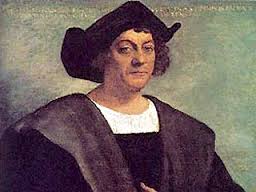 And this brings us to 1492 and the visit of Queen Isabella of Spain. An Italian sailor and map maker by the name of Christopher Columbus had come to the court of Spain to seek patronage and ships for exploration.
And this brings us to 1492 and the visit of Queen Isabella of Spain. An Italian sailor and map maker by the name of Christopher Columbus had come to the court of Spain to seek patronage and ships for exploration.
King Ferdinand and Queen Isabella listened to Columbus’ plea but eventually refused his request--three times.
However, something about the Italian sailor and something about his vision was not as easily refused. The Queen decided she needed to pray through his request for Spain’s patronage and the place to do it was the Monastery of Guadalupe. And the one whose intercession she sought to implore was the Madonna from whom her own kingdom had benefited so powerfully.
Queen Isabella came home from her retreat convinced that Spain should send Christopher Columbus on his voyage and that he should make a retreat at the Monastery before his departure. Columbus was delighted with the news and set off for Guadalupe to seek the prayerful intercession of the Woman whose image the tiny statue represented. Columbus returned to Spain encouraged and emboldened. He named his vessel the Santa Maria in honor of Our Lady of Guadalupe and sailed under her banner.
Life at sea was no easy feat in those days. Disease, pirates, and weather were the most common enemies of the sailor, and voyages could be plagued by many other maladies as well. Columbus experienced his fair share including the stealing of one of his ships by an insurgent captain and the grounding of his flagship, the Santa Maria, on a reef.
 When Columbus returned to Spain, he made his way to the Monastery of Guadalupe to make a retreat of thanksgiving and to express his gratitude to Our Lady for her intercession and maternal protection. He took with him to the Monastery the Native Americans who had traveled back to Spain under his care. And there, in the public square, using the water issuing forth from its fountain, these first travelers of the new land received the Sacrament of Baptism.
When Columbus returned to Spain, he made his way to the Monastery of Guadalupe to make a retreat of thanksgiving and to express his gratitude to Our Lady for her intercession and maternal protection. He took with him to the Monastery the Native Americans who had traveled back to Spain under his care. And there, in the public square, using the water issuing forth from its fountain, these first travelers of the new land received the Sacrament of Baptism.
Why do I think that Our Lady of Guadalupe was not carved by St. Luke the physician? The lady is black!
The Mexican War
The Spaniard Hernando Cortés landed on the Gulf shore of Mexico on Good Friday, April 22, 1519. According to one of his men, Bernal Diaz del Castillo, who recorded the events of the expedition, Cortés arrived with 508 soldiers on eleven ships, 100 sailors, 16 horses, a few cannons, crossbows and other pieces of artillery. They named the landing site Veracruz, “The True Cross.”
Their Chaplain, Father Bartolome de Olmedo, performed Mass on Easter Sunday. Cortés worked alongside his men to build a fort and left a contingent to protect the new settlement. He then sent one ship back to Spain with a letter that detailed their discovery for King Charles V. In an historic move to strengthen their resolve to conquer the land, Cortés burned his last ten ships in the harbor, cutting off any avenue of retreat.
Before we continue with this story, it is important that you learn these six facts about the Aztecs:
- The Aztecs ruled most of Central America in 1500, and their Empire, known as Mesoamerica, extended from the Gulf of Mexico to the Pacific Ocean and included the lands of Mexico, Guatemala, Belize, and portions of Honduras and El Salvador.
- Montezuma, considered the earthly representative of the sun god, became King of the Aztecs in 1503, and ruled from the capital Tenochtitlan and its sister-city Tlatelolco, both situated on an island in Lake Texcoco, the site of modern Mexico City. The inhabitants of the island were called the Mexica. Very similar to the pope at Rome in Vatican City. The pope is called the Vicar of Christ or the earthly representative of the son of God.
- Montezuma demanded heavy tribute from the surrounding Indian tribes, and was poised to conquer the remaining few regions of the dying Mayan civilization.
The city of Tenochtitlan was the center of religious worship for the Aztecs. Since the Mexica believed that the gods required human blood to subsist, the priests sacrificed thousands of living humans a year, generally captured Indians from surrounding tribes, in order to appease the frightful deities.
What does this remind you of? Vampires. Vampires need human blood to subsist. And if you think of the Roman Catholic Eucharist, that Roman Catholics believe that in each and every mass, the wine is miraculously turned into the actual blood of Jesus Christ each time by the priest. They are drinking the blood of the sacrificed God-man, which is forbidden in the Holy Scriptures. All Catholics then follow the form of a vampire, i.e. they drink blood.
Two gods important to understanding the events of history were Quetzalcóatl, the feathered serpent, and Tonantzin, the mother god. Quetzalcóatl was the god who founded the Aztec nation, but left when human sacrifice began, as he was opposed to the terrible ritual; but he vowed to return one day to reclaim his throne and redeem the Aztecs in the year 1-Reed, which occurred every 52 years in the Aztec time cycle.
Tonantzin was depicted as a terrifying figure, with her head comprised of snakes and her garment a mass of writhing serpents; her eyes projected fathomless grief. Tonantzin was worshipped at a stone temple in Tepeyac, about five miles from the capital Tenochtitlan.
- Montezuma’s sister, Princess Papantzin, lapsed in a coma in 1509. Upon her recovery, she related a dream that profoundly influenced the superstitious King. In her dream a luminous being with a black cross on his forehead led her to a shore with large ships that would come to their shores to conquer the Aztecs and bring them the true God. It was only ten years later, in the year 1-Reed, a year when Quetzalcóatl could return, that the Conquistadors of Spain arrived on the shores of Mexico.
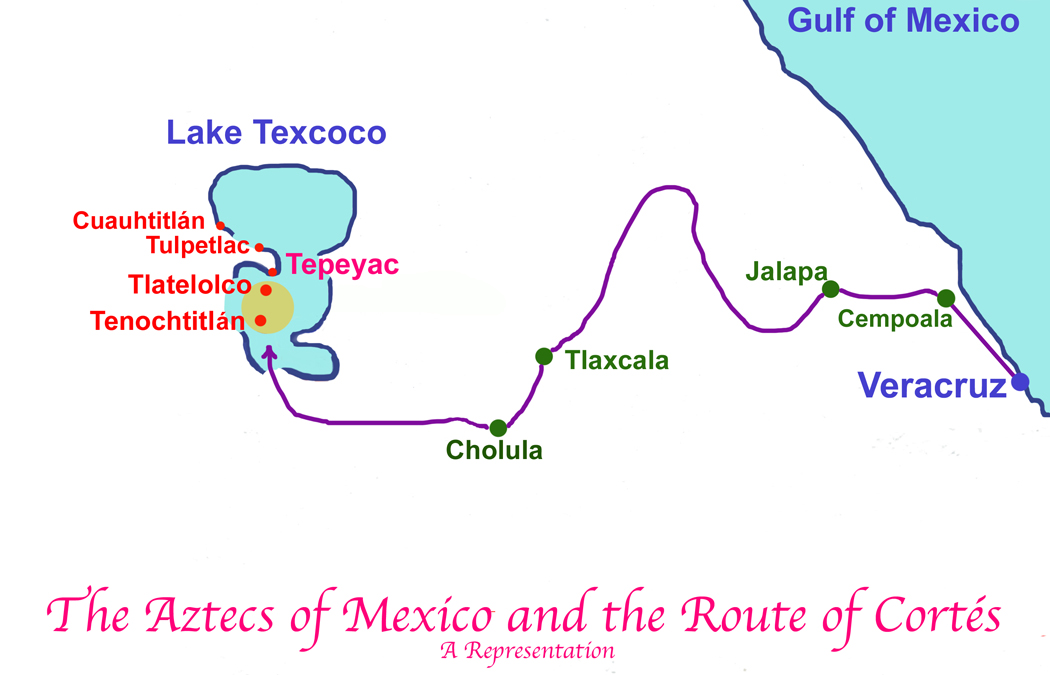 The expedition first went up the coast to Cempoala, where the heavily taxed tribe pledged their allegiance to Cortés. They continued through Jalapa, and headed towards Tlaxcala. They continued to find evidence of human sacrifice everywhere they went. This only strengthened their determination to stop the diabolic practice. At first the Tlaxcalans resisted the Spaniards. Cortés fought right alongside his men and forever earned their respect. Unable to defeat the Spaniards, the fierce Tlaxcalans finally joined forces with Cortes, and ultimately proved to be most valuable allies.
The expedition first went up the coast to Cempoala, where the heavily taxed tribe pledged their allegiance to Cortés. They continued through Jalapa, and headed towards Tlaxcala. They continued to find evidence of human sacrifice everywhere they went. This only strengthened their determination to stop the diabolic practice. At first the Tlaxcalans resisted the Spaniards. Cortés fought right alongside his men and forever earned their respect. Unable to defeat the Spaniards, the fierce Tlaxcalans finally joined forces with Cortes, and ultimately proved to be most valuable allies.
On the way to Tenochtitlan, Montezuma planned a trap in Cholula for Cortés, but the Spaniards and the Tlaxcalans overwhelmed the Chululan tribe, allies of the Mexica, and left 3000 dead.
It was then that Montezuma recalled the dream of his sister when he learned that a black cross adorned the helmets of the Spaniards. Because he believed that the Spanish leader was the returning god Quetzalcóatl, Montezuma refused to attack Cortés, and actually welcomed him on his arrival into Tenochtitlan on November 8, 1519, and housed the Spaniards in the palace of Montezuma’s father.
The Spaniards were appalled at the horrible spectacle of human sacrifice, and Cortés asked Montezuma to stop. But the sacrifice of adults and even children continued, and the Spaniards were awakened each morning by the screams of sacrificial victims. Cortés boldly placed Montezuma under house arrest one week after his arrival, and confined him to his palace.
Montezuma presented many gifts of gold, silver, and jewels to Cortés, but would not stop the demonic rituals. Finally, Cortés climbed the stairs of the main temple, had the priests remove the Aztec gods, and placed a Cross and image of the Blessed Virgin Mary. Father Olmedo said Holy Mass.
Soon afterwards, Cortés had to leave the city for political reasons, and placed Pedro de Alvarado in charge of Tenochtitlan. During the festival of the sun god in the spring of 1520, Alvarado decided to surround the Aztecs during their ritual ceremony in the temples, and slaughtered the unarmed celebrants. Outraged at this violation, the Mexica rose up in arms. Montezuma’s brother Cuitlahuac assumed leadership and fiercely attacked the Spaniards. Montezuma died in the battle. Cortés returned to Tenochtitlan to find the city in open warfare. The Spaniards and Tlaxcalans were soundly defeated and driven from the city on the Night of Sorrow, June 30, 1520.
However, Cortés returned to Tenochtitlan in May of 1521 with a massive army of native Indians, mostly Tlaxcalans. They were surprised to find half the population had died of a smallpox epidemic, including Cuitlahuac. The next--and last--Aztec King, Cuauhtémoc, fought Cortés for 93 days, but had to surrender the city on August 13, 1521. The once glorious city of Tenochtitlan was destroyed, and with it, the Aztec practice of human sacrifice. The conquest of Mesoamerica was complete.
What year was this? 1521. What else happened in the world in this year—the Diet of Worms. The Protestant Reformation was in its beginning stages and the Roman Catholic Church was losing millions of their white-Israelite members to Protestantism.
What Happened in Mexico?
Cortes’ first action as conqueror was to place the region under the Spanish crown and demolish the temples of sacrifice and build Catholic churches in their place, such as the Church Santiago de Tlatelolco on the site of the Temple of the sun god in present-day Mexico City.
Cortes did call for missionaries to convert the native Indians, and shortly after the Conquest, the Franciscan Peter Ghent from Belgium arrived in New Spain in August of 1523. He became known as Fray Pedro de Gante and adopted the ways of the Indians and lived a life of poverty among the natives. He learned Náhuatl, the native Aztec language, and soon appreciated that communication with the natives was through images, music, and poetry. He first began to educate the young, and the natives soon learned to trust him and listen to the Catholic message that he taught.
In May of 1524, twelve Franciscan missionaries arrived, some who affectionately became known by the natives for their self-sacrificing ways and others who attempted conversion by formal methods of catechism through translators. But they found the natives highly resistant to Catholicism, the religion of the Conquistadors, who had:
- killed thousands of Indians
- Raped their women
- Destroyed Tenochtitlan, the capital city
The Dominicans, the Augustinians, and the Jesuits Priests arrived shortly after this. In 1528 Charles V of Spain sent a group of five administrators known as the First Audience to govern Mexico. The First Audience was headed by Don Nuno de Guzman, who quickly proved cruel and ruthless in his treatment of the native population. He forced the native population either to abandon their villages or be reduced to slavery, branded them on the faces, and sold them in exchange for cattle.
To offset the First Audience, Charles V appointed Franciscan Friar Juan de Zumárraga as the first Bishop of Mexico City and Protector of the Indians in December of 1528. He accomplished much in his 25 years as Bishop, which included the establishment of the first grammar school, library, printing press, and the first college.
However, the Bishop spent much of his first year in Mexico objecting to the ruthless treatment of the Indians by de Guzman, who by then had sold 15,000 Indians into slavery. The First Audience applied strict censorship and forbade both Indians and Spaniards from bringing complaints to the Bishop. The Bishop countered with stern sermons against their use of military force, torture, and the imprisonment of Indians. Finally, in 1529, some Indians secretly smuggled a protest to Bishop Zumárraga concerning the heavy taxes and slave conditions in nearby Puebla. Bishop Zumárraga managed to send a message hidden in a crucifix back to Spain, and de Guzman was recalled. A Second Audience proved judicial to the Indians, but did not arrive in Mexico until 1531.
However, the Conquistadors and the First Audience had done grave damage to their relationship with the native population. The Indians were fed up with Spanish occupation, and resentment had reached a flash point. Isolated outbreaks of fights with the Spaniards had become inevitable, and Bishop Zumárraga feared a general insurrection. Such was the setting when the event of Tepeyac took place.
Wow! Europe was in a complete revolution and Mexico is about to have a general insurrection. What is happening to the Roman Catholic Church? It is quickly dying. But look at what happens next. This is what I did not know.
What are the three most important holidays in the Roman Catholic Church in Central America and South America and among all Catholic Latinos?
- Christ’s Mass
- Easter
- The celebration of Our Lady of Guadalupe
 The celebration of Our Lady of Guadalupe. What is that?
The celebration of Our Lady of Guadalupe. What is that?
Remember, last Sunday I told you about the Pope having secret meetings with the Greek Orthodox Catholic Church—the first time they had spoken in 1054 years. They met in Cuba after two years of secret meetings. It seems like the schism between the two Catholic churches is getting closer to ending.
Then Monday, I read what the Pope did in Mexico the next day. He crowned the Most Holy Virgin of Guadalupe. Who or what is the Most Holy Virgin of Guadalupe? I began to investigate this and it turned into this sermon.
At the conclusion of Holy Mass Saturday at the Basilica of Our Lady of Guadalupe in Mexico City, Pope Francis led the faithful in the Rite of Coronation of the image of the Most Holy Virgin of Guadalupe. It was a Marian apparition (vision of Mary) which brought together the culture of the Spaniards and the Aztecs. One of the main reasons was because “Our Lady” appeared as a mixed-race woman.
The Five Apparitions
The Aztec Indian Cuauhtlatoatzin, which means “the one who speaks like an eagle,” was born in 1474. He married a girl named Malintzin, and they lived with an uncle near Lake Texcoco. The three were among the few to be baptized in the early days, most likely by Father Toribio in 1525, and given the names Juan Diego and Maria Lucia, and the Uncle Juan Bernardino. Maria Lucia was childless, and died a premature death in 1529.
First Apparition:
Juan Diego Cuauhtlatoatzin was a widower at age 55, and turned his life to God. It was his custom to attend Mass and catechism lessons at the Church in Tlatelolco. At daybreak, on Saturday, December 9, 1531, Juan Diego began his journey to Church. As he passed a hill named Tepeyac, on which once stood a temple to the Aztec mother god Tonantzin, he heard songbirds burst into harmony. Music and songbirds presaged something divine for the Aztec. The music stopped as suddenly as it had begun. A beautiful girl with tan complexion and bathed in the golden beams of the sun called him by name in Náhuatl, his native language, “Juan Diego!”
The young woman then said: “Dear little son, I love you. I want you to know who I am. I am the Virgin Mary, Mother of the one true God, of Him who gives life. He is Lord and Creator of heaven and of earth. I desire that there be built a temple at this place where I want to manifest Him, make him known, give Him to all people through my love, my compassion, my help, and my protection. I truly am your merciful Mother, your Mother and the Mother of all who dwell in this land, and of all mankind, of all those who love me, of those who cry to me, and of those who seek and place their trust in me. Here I shall listen to their weeping and their sorrows.
I shall take them all to my heart, and I shall cure their many sufferings, afflictions, and sorrows. So run now to Tenochtitlan and tell the Lord Bishop all that you have seen and heard.”
First visit to the Bishop:
Juan Diego went to the palace of the Franciscan Bishop Juan de Zumárraga, and after rude treatment by the servants, was granted an audience with the Bishop. The Bishop was cordial but hesitant on the first visit and said that he would not consider the request of the Lady that he saw in a vision, but politely invited Juan Diego to come visit again.
Second Apparition:
Dismayed, Juan returned to the hill and found Mary waiting for him. He asked her to send someone more suitable to deliver her message “for I am a nobody.”
The Lady said on this second visit:
“Listen, little son. There are many I could send. But you are the one I have chosen for this task. So, tomorrow morning, go back to the Bishop. Tell him it is the ever holy Virgin Mary, Mother of God who sends you, and repeat to him my great desire for a church in this place.”
Second visit to the Bishop:
So, Sunday morning, December 10, Juan Diego called again on the Bishop for the second time. Again with much difficulty, he was finally granted an audience. The Bishop was surprised to see him and told him that he needed a sign from the Lady before he could build a church, as she requested.
Third Apparition:
Juan Diego reported this to the Virgin and she told him to return the following morning (Monday) for the sign. However, when Juan Diego returned home he found his uncle Juan Bernardino gravely ill. Instead of going back to Tepeyac, he stayed home with his dying uncle on Monday.
Fourth Apparition:
Juan Diego woke up early Tuesday morning, December 12th, 1531 to bring a priest from the Church of Santiago at Tlatelolco, so that his uncle might receive the last rites. Juan had to pass Tepeyac hill to get to the priest. Instead of the usual route by the west side of the hill, he went around the east side to avoid the Lady. Guess who descended the hill on the east side to intercept his route! It was the Virgin Lady.
She said:
“Least of my sons, what is the matter?”
Juan was embarrassed by her presence. “My Lady, why are you up so early? Are you well? Forgive me. My uncle is dying and desires me to find a priest for the Sacraments. It was no empty promise I made to you yesterday morning. But my uncle fell ill.”
Mary said: “My little son. Do not be distressed and afraid. Am I not here who am your Mother? Are you not under my shadow and protection? Am I not the fountain of your joy? Are you not in the fold of my mantle, in the cradle of my arms?
Your uncle will not die at this time. This very moment his health is restored. There is no reason now for your errand, so you can peacefully attend to mine. Go up to the top of the hill; cut the flowers that are growing there and bring them to me.”
Flowers in December? Impossible, thought Juan Diego. But he was obedient, and sure enough found beautiful Castilian roses on the hilltop. As he cut them, he decided the best way to protect them against the cold was to cradle them in his tilma -- a long, cloth cape worn by the Aztecs, and often looped up as a carryall. He ran back to Mary and she rearranged the roses and tied the lower corners of the tilma behind his neck so that nothing would spill, and said:
“You see, little son, this is the sign I am sending to the Bishop. Tell him that now he has his sign, he should build the temple I desire in this place. Do not let anyone but him see what you are carrying.
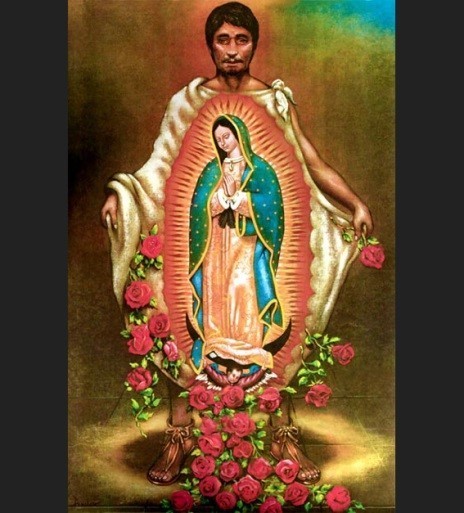 Hold both sides until you are in his presence and tell him how I intercepted you on your way to fetch a priest to give the Last Sacraments to your uncle, how I assured you he was perfectly healed and sent you up to cut these roses, and myself arranged them like this. Remember, little son, that you are my trusted ambassador, and this time the Bishop will believe all that you tell him.”
Hold both sides until you are in his presence and tell him how I intercepted you on your way to fetch a priest to give the Last Sacraments to your uncle, how I assured you he was perfectly healed and sent you up to cut these roses, and myself arranged them like this. Remember, little son, that you are my trusted ambassador, and this time the Bishop will believe all that you tell him.”
Third visit to the Bishop:
Juan went to see the Bishop and explained all that had happened. Then Juan put up both hands and untied the corners of crude cloth behind his neck. The looped-up fold of the tilma fell; the flowers he thought were the precious sign tumbled out on the floor.
The Bishop rose from his chair and fell on his knees in adoration before the tilma, as well as everyone else in the room. For on the tilma was the image of the Blessed Virgin Mary just as described by Juan Diego.
Fifth Apparition:
Meanwhile, in the course of these events, Juan Bernardino, the dying uncle, suddenly found his room filled with a soft light. A luminous young woman filled with love was standing there and told him he would get well. She told him that she had sent his nephew, Juan Diego, to the Bishop with an image of herself and said, “Call me and my image the ever Virgin Saint Mary of Guadalupe.”
The Impact
The news of the appearance of the dark--skinned Aztec Indian Virgin mother who left her imprint on the tilma spread like wildfire! Three points were appreciated by the native population.
- The Virgin lady was an Aztec Indian, spoke Náhuatl, the Aztec language, and appeared to another Aztec, not a Spaniard!
- Juan Diego explained that she appeared at Tepeyac, the place of Tonantzin, the mother god, sending a clear message that the Virgin Mary was the mother of the true God, and that the Catholic religion was to replace the Aztec religion. Montezuma believed this also that it was the Spaniard Cortez who was really the departed god Quetzalcoatl who was going to return and give them the true God.
- And third, the Indians, who learned through pictures and symbols in their culture of the image, grasped the meaning of the tilma, which revealed the message of Catholicism: the true God sacrificed himself for mankind, instead of the horrendous life they had endured sacrificing humans to appease the frightful gods! The Lady’s gown was full of Aztec symbolism as well as the fact that she was standing on the crescent moon.
It is no wonder that over the next seven years, from 1531 to 1538, nine million natives of Mexico converted to Catholicism! That means that they had to baptize an average of 3700 baptisms every day! Since that time, the Virgin, under the title of Our Lady of Guadalupe, has been proclaimed Patroness of Mexico, Patroness and Empress of the Americas, and Heavenly Patroness of the Philippines. She is also known as the Protectress of Unborn Children.
The Shrine of Our Lady of Guadalupe is one of the most visited pilgrimage places in the world, with millions of pilgrims coming each year to venerate the sacred image. Seven million people from the Americas visit the Virgin of Guadalupe every year, especially on December 12, the annual celebration of the miracle.
If one visits Mexico City, one can plainly see who has the heart of the people. One finds the Virgin of Guadalupe pictured everywhere in Mexico City, in the airport, taxis, bakeries (remember the opening Scripture), even on street corners. Our Lady has been the factor that has preserved the Aztec Indians from the cultural disintegration observed with other Indian populations such as in North America.
Popes through the ages have recognized Our Lady of Guadalupe, and Pope John XXIII was the first to call the Virgin Mother of the Americas on October 12, 1961. John Paul II was the first Pope to visit the Guadalupe shrine on January 27, 1979. On January 23, 1999 in his Homily at the Basilica of Our Lady of Guadalupe, Pope John Paul II, referring to all of the Americas as one single continent, called the Virgin of Guadalupe the Mother of America.
Pope John Paul II canonized the Aztec Indian, Juan Diego; a Saint on July 31, 2002. Soon after the Aztecs joined the Catholic Church, not because of what it taught, but because of the Lady of Guadalupe, the other Indian tribes in Central and South America also joined the Catholic Church for the same reason.
The Catholic Church remains firmly entrenched in Mexico and Latin America, which today are more than 90% Catholic. The Catholic Church of the United States with 77 million Catholics can attribute much of our recent growth to the Hispanic population of North America.
The Catholic Virgin is not Mary. The Catholic Virgin is often called the “Queen of Heaven” a title of Astarte (Ishtar) and a counterfit Mother of the Seed of the Woman (Genesis 3:15).
Tonantzin is the Catholic Virgin and the Catholic Virgin is not Mary but Astarte (Semiramis queen of Babylon). A Shrine was built on the remains of an temple of Tonantzin, destroyed by the Spanards. It produced the largest number of converts in history—9 million converts in 7 years; 3700 baptisms a day. The entire region of Mexico imbraced this new version of the old religion. It is the only large conversion in the world that was voluntary, not forced.
Conclusion
And Mary died. What condition was or is she in now. She has made 9 apparitions in different parts of the world so far, according to the Roman Catholic Church. She has appeared as a black person and a brown Indian, taught the people how to say the rosary, and converted more people in a short time than anywhere else in the world.
And yet the “Queen of Heaven” is worshipped in many countries and cities in the world. In the United States, there are major celebrations in Sante Fe, New Mexico; New York City; Lubbord, Texas and others.

Riding in his pope mobile, on a carpet of flowers, John Paul II salutes the crowd in Mexico City, on July 31, 2002. On the left, the New Basilica of Guadalupe, completed in 1976, and on the right, the Old Basilica. 10 million people gathered along the streets on the day to see the Pope. No human being has ever drawn so many people in one day in history.
So, just one “Marian apparition” has been claimed to have been effective in turning most of the Latin people living in the Americas as being predominantly Roman Catholic–this profoundly affected those cultures and the world; an Aztec goddess was modified to become a recruitment tool.
 Every year on Sunday nearest to December 12th, Roman Catholic churches across Lubbock, Texas celebrate the feast of Our Lady of Guadalupe. To Lubbock’s Mexican American Catholic community, the Guadalupe devotion celebrates not only a manifestation of the Blessed Virgin Mary but also a culture. This relationship between the Lady of Guadalupe and Mexican America Catholics in Lubbock is at least as complex and diverse as her relationship with those in her native Mexico. Here she offers cultural and religious connections to a people whose homeland is still being defined.
Every year on Sunday nearest to December 12th, Roman Catholic churches across Lubbock, Texas celebrate the feast of Our Lady of Guadalupe. To Lubbock’s Mexican American Catholic community, the Guadalupe devotion celebrates not only a manifestation of the Blessed Virgin Mary but also a culture. This relationship between the Lady of Guadalupe and Mexican America Catholics in Lubbock is at least as complex and diverse as her relationship with those in her native Mexico. Here she offers cultural and religious connections to a people whose homeland is still being defined.
And less than 2 miles from our own church here in Kentucky, there is a Roman Catholic Church whose name is: Mary, Queen of Heaven. The church is right next to St. 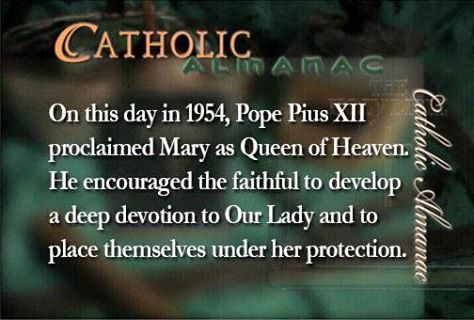 Henry High School. Do you think there is any connection to Our Lady of Guadalupe? And there are a host of others, such as: Our Mother of Sorrows Catholic Church, Mother of God Catholic Church, Our Lady of Victory Catholic Church, Our Lady of Lourdes, St. Mary Catholic Church, Mother of Christ Catholic Church, Immaculate Heart of Mary Catholic Church, Our Lady Sacred Heart Catholic Church, etc. Whose church is it, anyway?
Henry High School. Do you think there is any connection to Our Lady of Guadalupe? And there are a host of others, such as: Our Mother of Sorrows Catholic Church, Mother of God Catholic Church, Our Lady of Victory Catholic Church, Our Lady of Lourdes, St. Mary Catholic Church, Mother of Christ Catholic Church, Immaculate Heart of Mary Catholic Church, Our Lady Sacred Heart Catholic Church, etc. Whose church is it, anyway?
Beware of any similar future apparitions of the Virgin. Israelites, come out of her, for she is a part of Mystery Babylon.
Blessed be the Lord God of Israel.

